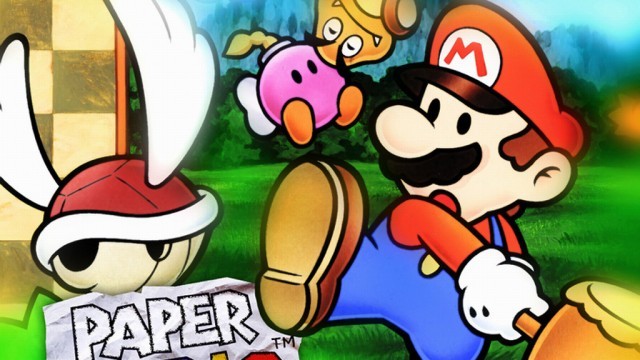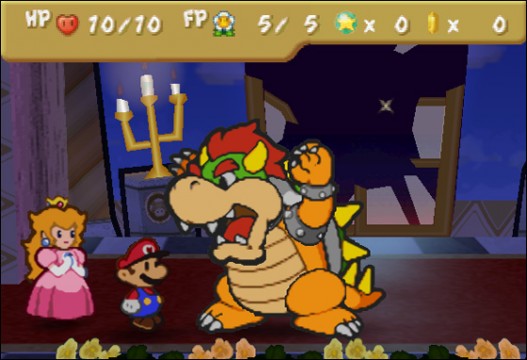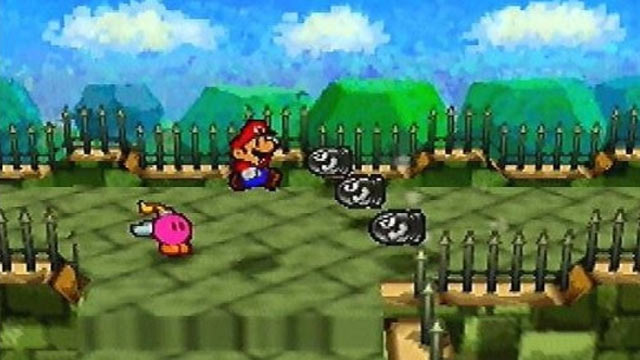
A little over 14 years after Intelligent Systems was first established in 1986, it seems only then was the studio deemed worthy enough to take responsibility of Nintendo’s biggest franchise, Mario himself.
Despite not being completely left to its own devices when creating Paper Mario for Nintendo 64 (Shigeru Miyamoto being one of the producers and consultants for the title and keeping a firm eye on things), Intelligent Systems did not take the easy way out and come up with just another run of the mill platformer. Instead, it took its influence from Squares’ Mario entry, Super Mario RPG: Legend of the Seven Stars, and created Paper Mario, known in Japan as Mario Story and originally billed as the sequel, “Super Mario RPG 2.”
Set in the Mushroom Kingdom, Princess Peach has once again managed to get herself kidnapped by Bowser, who now has in his possession the Star Rod which grants him anything he wishes and also renders him invincible. It’s up to Mario to free the seven star spirits that, when combined, will allow him to defeat Bowser, rescue the Princess, and retrieve the Star Rod.

Although this plot sounds very familiar and may not win anything for originality, Paper Mario turned out to be quite a complex game and probably more so than you may remember. Taking elements from many RPGs of the day, Paper Mario used a turn-based battle system in which you were required to deplete your enemies’ HP (Health/Hit Points) to zero in order to defeat them whilst also maintaining your own.
This meant that you now had to think defensively in order to progress and not simply rely on the old faithful jump on the head, spit of a fireball, or a flick of the tail from the Tanooki Suit. With HP came more abbreviations and statistics to manage. FP (Flower Points) were similar to your mana or magic points in other RPGs and allowed Mario and anyone in his party to perform special moves. BP (Badge Points) were used to equip powerful items that aided Mario and his party in battle and were essentially spent once a badge was equipped. These could later be shuffled to free up much needed BP to equip even more powerful items that were acquired further on in the game. Finally there were Star Points, which were essentially experience points, and for every 100 Star Points collected you then got the option to level up your HP, BP or FP.
In addition to the upgrade system, you also had a buddy to manage. Along his travels Mario would accumulate friends/partners who would tag along for the adventure, each bringing their own unique skills to the game. These skills would be vital in defeating certain enemies or completing particular puzzles, and it was up to you to work out which friend was best suited to a situation.
For me, one of the elements that set Paper Mario apart from his previous RPG outing was the ability to influence the power of an attack during battle with the introduction of action commands. Much like the quick-time events you find in games today, these commands required a specific button press that, if timed just so, would enhance your attack and cause massive amounts of damage, particularly in the later stages of the game when you were all beefed up and ready for Bowser!

Aside from the main missions and chapters in the game, Intelligent Systems even found time to put in a number of interludes in which you took control of Princess Peach. Not only did these scenes serve as an insight into to what was going on whilst Mario was busily trying to save Peach, they were also genuinely enjoyable to play out. The scenes often involved stealth in some form or another, but the game would sometimes throw a curveball and have you suddenly baking a cake or appearing on the 64th Trivia Quiz Off Game Show. Genius!
All in all, Paper Mario is an absolute triumph and will always be that little bit extra special for me. Unfortunately, I was one of the many disappointed UK SNES owners back in the mid ’90s that never got to play the original Super Mario RPG due to the Japan/US only release, so when this finally hit our shores in 2001 I was over the paper moon! For its day it looked absolutely stunning with its mix of 2D character models and 3D environments that would sweep in and out on your TV screen as you traversed the levels. The soundtrack was equally as good and in keeping with the Mario world we know and love, and the gameplay was a refreshing change from the usual platform capers we come to expect from a Mario game. Yes, it may have been a little corny and probably not for the hardcore gamer of today, but it’s no fluke that this game was able to stand alongside some of the best RPGs ever made at the time, was the biggest selling game in Japan on its week of release, and has since spawned three further games in the series. I’d call that a success!




 ShareThis
ShareThis







i love paper mario! I wish that intelligent systems stopped working on too many fire emblems games and make a new paper mario game for wii u. The one from3ds was a blast, even though it didn´t have partners or badges, the charisma and jokes were there ^^